当前位置:
X-MOL 学术
›
Acta Geol. Sinica Engl. Ed.
›
论文详情
Our official English website, www.x-mol.net, welcomes your
feedback! (Note: you will need to create a separate account there.)
The Biomarkers in the Mesoproterozoic Organic-rich Rocks of North China Craton: Implication for the Precursor and Preservation of Organism in the Prokaryotic Realm
Acta Geologica Sinica-English Edition ( IF 3.5 ) Pub Date : 2021-06-21 , DOI: 10.1111/1755-6724.14773 Sihong MA 1 , Shuichang ZHANG 1 , Jin SU 1 , Xiaomei WANG 1 , Kun HE 1 , Yu FANG 1 , Jingkui MI 1
Acta Geologica Sinica-English Edition ( IF 3.5 ) Pub Date : 2021-06-21 , DOI: 10.1111/1755-6724.14773 Sihong MA 1 , Shuichang ZHANG 1 , Jin SU 1 , Xiaomei WANG 1 , Kun HE 1 , Yu FANG 1 , Jingkui MI 1
Affiliation

|
Mesoproterozoic marine organic-rich rocks are widely distributed in the North China Craton, include the Gaoyuzhuang (GYZ), the Hongshuizhuang (HSZ), and the Xiamaling (XML) formations. According to the Tmax value and isomerisation ratio of C31 homohopanes, the XML, HSZ, and GYZ samples were in low mature, mature and high mature stage, respectively. Biomarker distribution in extractable organic matter (EOM) of three Mesoproterozoic organic-rock samples in different maturity were analysed to reveal the organic precursor and preservation pathway of in the Mesoproterozoic Combined with gold-tube pyrolysates of three Mesoproterozoic samples, it could further illuminate the chemical composition of Mesoproterozoic kerogen, given excluding. The results indicated that the three formations were all deposited under reducing condition and their organic precursors mainly were some aquatic organisms. High content of rearranged hopanes was detected in EOM of XML and HSZ samples, whereas they were relatively low in the high mature GYZ sample. Contrast to that in EOM, the relative concentration of rearranged hopanes sharply decreased in the gold-tube pyrolysates of the XML kerogen, then slightly increased but was still significantly lower than the EOM of XML sample, which indicated that catalysis of clay minerals in the early diagenesis only changed the chemical composition of the unstable functional groups of the kerogen during the preservation. Due to the thriving heterotrophic microbes and low sink rate of particulate organic matter during the Mesoproterozoic, primary producers suffered extensive degradation during sinking process, only some resistant biopolymers lacking of lipid compounds survived from heterotrophic degradation, while heterotrophic microbes contained more proportion of organic precursors. Abundant pristane (Pr) and phytane (Ph) were only released in high mature stage because of the protection of the macromolecular structure of resistant biopolymers which prevented biomarkers from being altered by the thermal stress. The absence of 13α(n-alkyl)-tricyclic terpanes in the high matured hydrocarbon products also indicated the different precursors between different parts of Mesoproterozoic kerogen. The evolution of the biomarker composition and content of Mesoproterozoic kerogen showed some special characteristics differing from those of Phanerozoic kerogen. The total concentrations of hopanes displayed with an order of low mature stage > high mature stage > mature stage. Relative content of rearranged hopanes in the hydrocarbon generated in high mature stage was significantly lower than that in the low maturity stage. The ratios of Pr/n-C17 and Ph/n-C18 increased with thermal maturity, and the ratio of nC21-/nC22+ decreased in the high maturity stage, thus displaying another order of mature stage > high maturity stage > low maturity stage. The unique preservation pathway of Mesoproterozoic organisms was attributed to the special evolution characteristics of biomarker distributions, which should be considered in the Mesoproterozoic marine environment and biological studies.
中文翻译:

华北克拉通中元古代富有机质岩石中的生物标志物:对原核生物前体和保存的启示
中元古代海相富有机质岩石广泛分布于华北克拉通,包括高峪庄组(GYZ)、红水庄组(HSZ)和下马岭组(XML)。根据C 31的T max值和异构化率同藿烷、XML、HSZ和GYZ样品分别处于低成熟、成熟和高成熟阶段。分析了三个不同成熟度中元古代有机岩样品的可提取有机质(EOM)中的生物标志物分布,揭示了中元古代有机前体和保存途径,结合三个中元古代样品的金管热解物,可以进一步阐明化学中元古代干酪根的组成,不包括在内。结果表明,这三个地层均在还原条件下沉积,其有机前体主要是一些水生生物。在 XML 和 HSZ 样品的 EOM 中检测到重排藿烷含量较高,而在成熟度较高的 GYZ 样品中含量相对较低。与 EOM 中的相比,XML干酪根金管热解物中重排藿烷的相对浓度急剧下降,然后略有增加,但仍显着低于XML样品的EOM,表明早期成岩作用粘土矿物的催化仅改变了化学成分保存过程中干酪根的不稳定官能团。由于中元古代异养微生物繁盛,颗粒有机物沉降率低,初级生产者在沉降过程中遭受了广泛的降解,只有一些缺乏脂质化合物的抗性生物聚合物从异养降解中幸存下来,而异养微生物则含有更多比例的有机前体。由于抗性生物聚合物的大分子结构受到保护,可防止生物标志物因热应力而改变,因此仅在高成熟阶段才释放出丰富的鲸鲨烷(Pr)和植烷(Ph)。没有 13α(高成熟烃产品中的正烷基)-三环萜烷也表明了中元古代干酪根不同部位的前驱体不同。中元古代干酪根生物标志物组成和含量的演变呈现出一些不同于显生宙干酪根的特殊特征。藿烷总浓度显示为低熟期>高熟期>成熟期。高成熟期生烃中重排藿烷的相对含量明显低于低成熟期。Pr/ n -C 17和 Ph/ n -C 18的比值随着热成熟度的增加而增加,n C 21-的比值/ n C 22+在高成熟期下降,呈现出成熟期>高成熟期>低成熟期的顺序。中元古代生物独特的保存途径归因于生物标志物分布的特殊进化特征,应在中元古代海洋环境和生物学研究中予以考虑。
更新日期:2021-06-21
中文翻译:

华北克拉通中元古代富有机质岩石中的生物标志物:对原核生物前体和保存的启示
中元古代海相富有机质岩石广泛分布于华北克拉通,包括高峪庄组(GYZ)、红水庄组(HSZ)和下马岭组(XML)。根据C 31的T max值和异构化率同藿烷、XML、HSZ和GYZ样品分别处于低成熟、成熟和高成熟阶段。分析了三个不同成熟度中元古代有机岩样品的可提取有机质(EOM)中的生物标志物分布,揭示了中元古代有机前体和保存途径,结合三个中元古代样品的金管热解物,可以进一步阐明化学中元古代干酪根的组成,不包括在内。结果表明,这三个地层均在还原条件下沉积,其有机前体主要是一些水生生物。在 XML 和 HSZ 样品的 EOM 中检测到重排藿烷含量较高,而在成熟度较高的 GYZ 样品中含量相对较低。与 EOM 中的相比,XML干酪根金管热解物中重排藿烷的相对浓度急剧下降,然后略有增加,但仍显着低于XML样品的EOM,表明早期成岩作用粘土矿物的催化仅改变了化学成分保存过程中干酪根的不稳定官能团。由于中元古代异养微生物繁盛,颗粒有机物沉降率低,初级生产者在沉降过程中遭受了广泛的降解,只有一些缺乏脂质化合物的抗性生物聚合物从异养降解中幸存下来,而异养微生物则含有更多比例的有机前体。由于抗性生物聚合物的大分子结构受到保护,可防止生物标志物因热应力而改变,因此仅在高成熟阶段才释放出丰富的鲸鲨烷(Pr)和植烷(Ph)。没有 13α(高成熟烃产品中的正烷基)-三环萜烷也表明了中元古代干酪根不同部位的前驱体不同。中元古代干酪根生物标志物组成和含量的演变呈现出一些不同于显生宙干酪根的特殊特征。藿烷总浓度显示为低熟期>高熟期>成熟期。高成熟期生烃中重排藿烷的相对含量明显低于低成熟期。Pr/ n -C 17和 Ph/ n -C 18的比值随着热成熟度的增加而增加,n C 21-的比值/ n C 22+在高成熟期下降,呈现出成熟期>高成熟期>低成熟期的顺序。中元古代生物独特的保存途径归因于生物标志物分布的特殊进化特征,应在中元古代海洋环境和生物学研究中予以考虑。











































 京公网安备 11010802027423号
京公网安备 11010802027423号